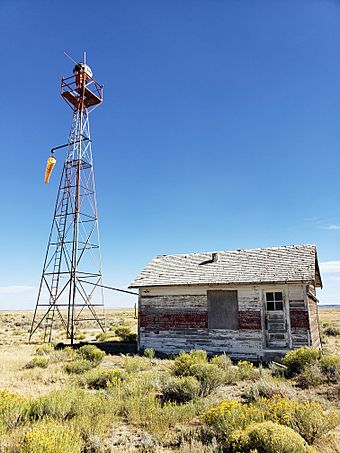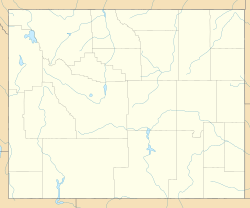Medicine Bow Airport facts for kids
Quick facts for kids |
|
|
Site 32 SL-O Intermediate Field Historic District
|
|
 |
|
| Location | Medicine Bow, Wyoming |
|---|---|
| Built | 1929 |
| NRHP reference No. | 12000054 |
| Added to NRHP | February 28, 2012 |
The Site 32 SL-O (Salt Lake-Omaha) Intermediate Field Historic District, also known as the Medicine Bow Airport (FAA LID: 80V), is a special airport from the early days of flying. It's located near Medicine Bow, Wyoming. This airport was a key part of the Transcontinental Airway System, which helped pilots fly across the United States.
Contents
What Was the Transcontinental Airway System?
Imagine trying to fly a plane across a huge country like the United States in the 1920s. There were no GPS systems or fancy radar back then! Pilots had to rely on their eyes and simple maps. To make flying safer and easier, the U.S. government created the Transcontinental Airway System.
Guiding Pilots Across the Country
This system was like a highway in the sky, but instead of roads, it used a series of lighted beacons. These beacons were placed about 10 to 15 miles apart. Each beacon had a powerful light that flashed a special code, helping pilots know exactly where they were.
How Did the Beacons Work?
Each beacon was built on a concrete arrow, which was often 50 to 70 feet long. This giant arrow pointed directly to the next beacon in the chain. So, pilots could see the flashing light at night and follow the arrow during the day. It was a clever way to guide planes across vast distances, especially over mountains and plains.
The Medicine Bow Airport's Role
The Medicine Bow Airport was one of these important "intermediate fields." It was built in 1929. An intermediate field was a small airport located between major cities. These fields provided a place for pilots to land if they needed to refuel, rest, or wait out bad weather.
What Made Medicine Bow Special?
At Medicine Bow, there was a constantly lit beacon and a large cement arrow. This arrow pointed the way to the next beacon on the Salt Lake-Omaha airway route. This route was a vital path for mail and passenger planes traveling between the western and central parts of the country.
Why Was This Airport Important?
The Medicine Bow Airport played a big role in the early days of aviation. It helped make air travel safer and more reliable. Before systems like this, flying long distances was very risky. These lighted airways helped connect the country and paved the way for modern air travel. Today, the site is recognized as a historic district because of its importance to aviation history.


